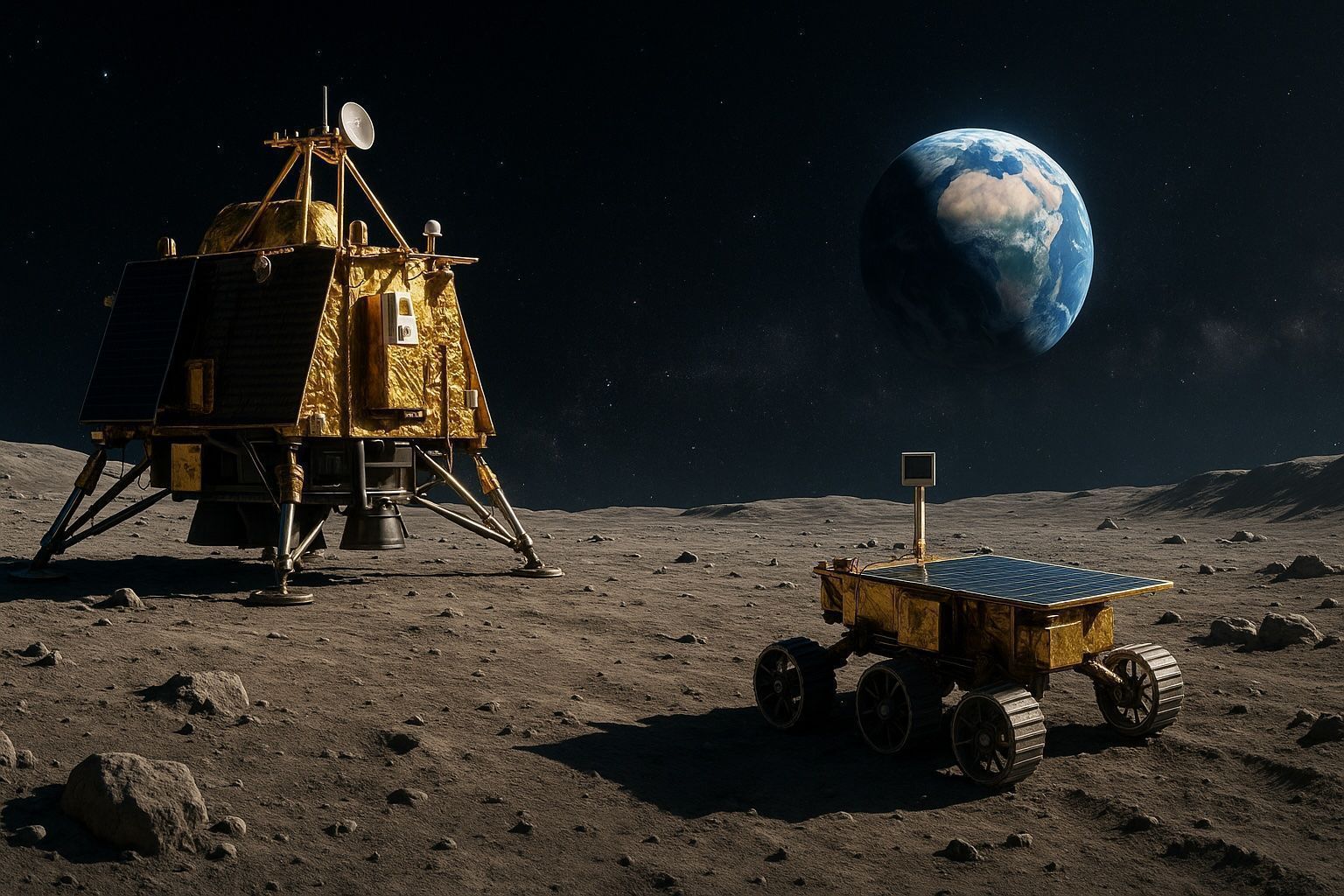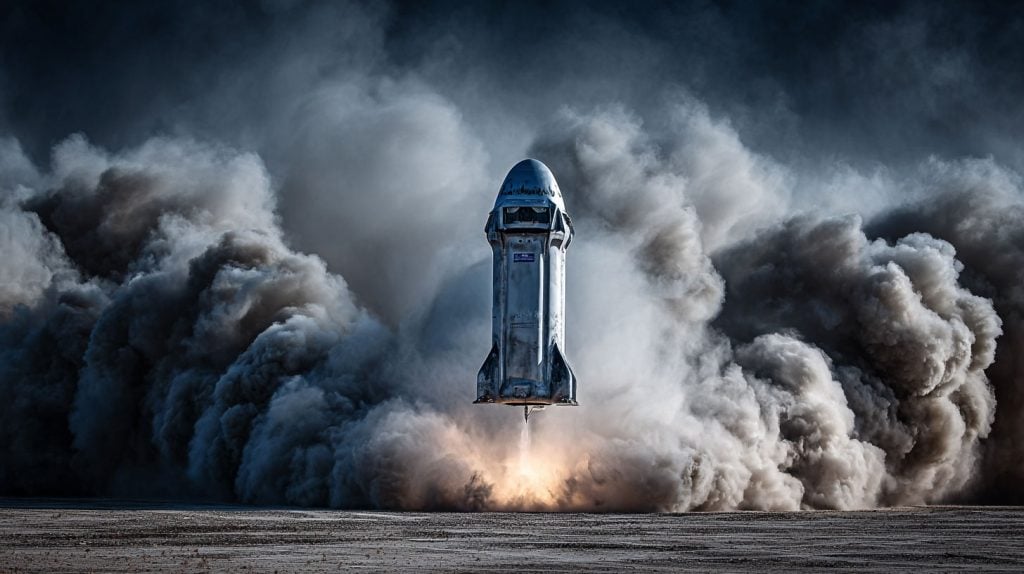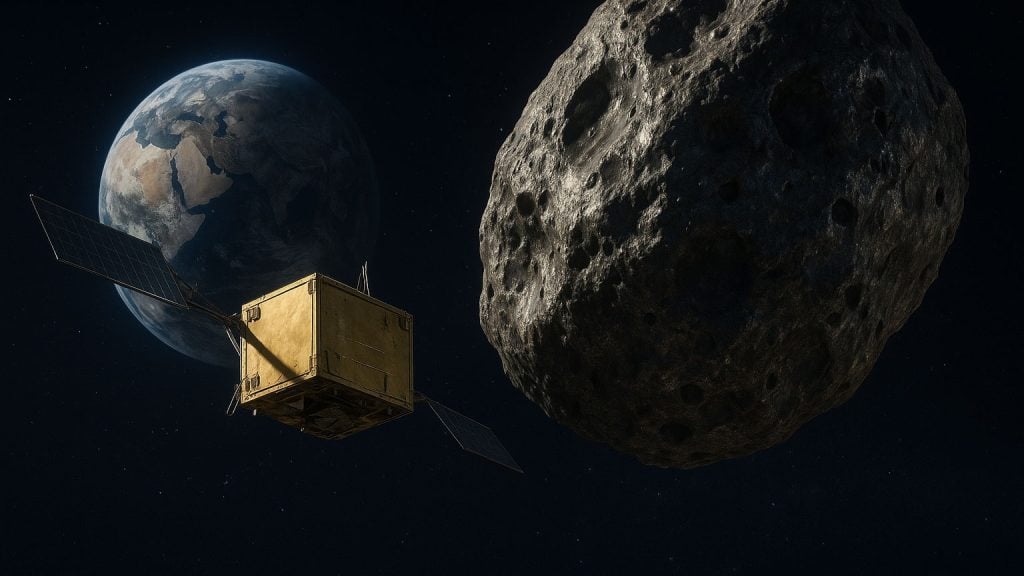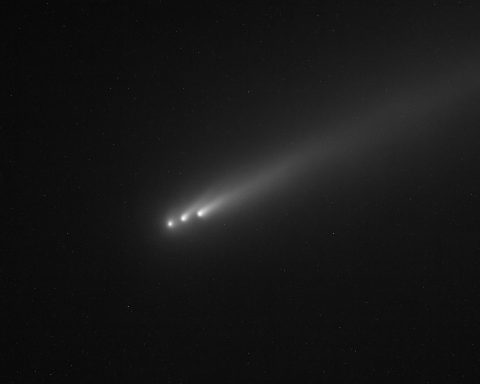- Chandrayaan-3, launched July 2023, achieved a soft landing near the Moon’s south pole on August 23, 2023, with lander Vikram and six-wheeled rover Pragyan.
- The mission conducted 14 days of surface operations and returned at least 1100 images and data, including ChaSTE soil temperature measurements to 10 cm depth.
- Chandrayaan-3 marked India’s first soft landing in the lunar south polar region and made India the fourth country to soft-land on the Moon.
- The mission cost was about $75 million.
- India’s Mars Orbiter Mission (MOM / Mangalyaan-1) launched on November 5, 2013 atop a PSLV-XL, with a dry mass of about 1,350 kg and ~852 kg of fuel, and arrived in Martian orbit on September 24, 2014.
- MOM carried a ~15 kg science payload including MCC, Lyman-Alpha Photometer, Thermal Imaging Spectrometer, MENCA, and a Methane Sensor, and yielded over 1100 images plus a Mars Atlas and more than 35 peer-reviewed papers.
- MOM detected suprathermal argon with MENCA and, during dust storms, atomic oxygen exceeding CO2 at about 270 km altitude, while the methane sensor was not sensitive enough to detect Martian methane.
- MOM operated for about 8 years, far exceeding its design life of 6–10 months, with contact lost in 2022.
- Mangalyaan-2 plans call for a Mars lander/rover with a helicopter drone, using direct-entry EDL, launched on ISRO’s LVM3 around 2026 or later for a 2030–2031 landing, carrying instruments MODEX, RO, EIS, and LPEX.
- The Chandrayaan-3 success is expected to lift India’s private-sector space startups and advance a national vision of space leadership by 2047, with ISRO citing international collaboration and data-sharing potential.
India’s Chandrayaan-3 mission (launched July 2023) achieved a historic soft landing near the Moon’s south pole on August 23, 2023 [1]. Its primary objectives were to demonstrate safe, precise landing and a mobile rover to conduct in‑situ science on the lunar surface [2]. The mission carried a lander (Vikram) and a six-wheeled rover (Pragyan) equipped with instruments (e.g. spectrometers and a thermal probe) to analyze soil composition and surface properties [3] [4]. Nearly two hours after touchdown, ISRO announced “We have achieved soft landing on the moon! India is on the moon!” [5], making India the fourth country ever to soft-land on the Moon and the first to reach the south polar region [6].
- Objectives: Soft-landing and roving, demonstration of advanced navigation/sensing technologies [7].
- Achievements: 14-day surface operations (one lunar day) by Vikram and Pragyan; first in-situ measurements near lunar south pole; ≥1100 images and data returned. For example, the lander’s ChaSTE instrument probed soil temperature to 10 cm depth, revealing milder conditions that suggest polar slope regions may harbor accessible ice.
- Impact: The mission cost only ~$75 million [8], exemplifying ISRO’s frugal innovation. Its success drew global attention and national pride (Prime Minister Modi hailed it as belonging “to all of humanity” [9]). It also spurred India’s space industry: industry leaders note the landing “expected to provide a lift for the country’s private-sector space start-ups,” as the government opens the space sector to investment [10].
India’s First Mars Probe (MOM – Mangalyaan-1)
Launched on Nov 5, 2013 atop a PSLV-XL rocket, India’s Mars Orbiter Mission (MOM/Mangalyaan-1) was a technology-demonstration orbiter weighing ~1,350 kg dry (2,960 lb) with ~852 kg fuel [11] [12]. Its science payloads (total ~15 kg) included the Mars Colour Camera (MCC), Lyman-Alpha Photometer, Thermal Imaging Spectrometer, Mars Exospheric Neutral Composition Analyser (MENCA), and a Methane Sensor [13]. MOM used a fuel-efficient, multi-burn trajectory and arrived in Martian orbit on Sept 24, 2014 (after ~10 months) – a first successful orbit insertion on ISRO’s first try.
- Technical Highlights: A compact orbiter (≈482 kg dry, ~900 W power) with deployable solar panels; it initially entered a highly elliptical Earth orbit and then spiraled out to Mars [14] [15]. It carried 5 instruments (see list) to study Mars’s surface, atmosphere, and exosphere [16].
- Scientific Outcomes: MOM returned thousands of images and data. ISRO reports MCC produced over 1,100 images and a Mars Atlas, and the mission yielded 35+ peer-reviewed papers [17]. Key findings include observations of Martian weather, dust storms, and atmosphere loss: for instance, MENCA detected high-energy (“suprathermal”) argon and, unusually, found atomic oxygen exceeding CO₂ at ~270 km altitude during dust-storm season [18]. It also mapped atmospheric optical depth and cloud features [19]. However, one challenge emerged: the methane sensor was not sensitive enough for Martian methane detection, so no methane data were obtained [20].
- Mission Life & End: Designed for 6–10 months, MOM far exceeded expectations, operating ~8 years. In 2022 ISRO lost contact (likely due to depleted fuel and battery during prolonged eclipse periods) [21] [22]. ISRO called MOM “a remarkable technological and scientific feat” in planetary exploration [23].
Table 1. Mars Orbiter Mission (Mangalyaan-1) summary [24] [25]
| Parameter | Value |
|---|---|
| Launch Date (UT) | Nov 5, 2013, 09:08 |
| Launch Vehicle | PSLV-XL (Polar Satellite Launch Vehicle) |
| Spacecraft Mass (wet/dry) | ~1,350 kg (including ~852 kg fuel) |
| Target / Orbit Insertion | Mars (Sept 24, 2014, areocentric orbit) |
| Mission Life (design/actual) | 6–10 months / ~8 years |
| Power | ~800 W (solar panels) |
| Instruments | Mars Color Camera, Lyman-Alpha Photometer, Thermal IR Spectrometer, MENCA, Methane Sensor [26] |
| Achievements | First Asian orbiter at Mars; 1100+ images; >35 science papers [27] [28] |
Mars Lander Mission (Mangalyaan-2): Plans and Objectives
Building on MOM’s success and Chandrayaan-3’s landing technologies, ISRO is planning Mangalyaan-2 (Mars Orbiter/Lander Mission), a Mars lander/rover mission. This will be India’s first attempt to land on another planet, aiming to place a rover on Mars and conduct surface science [29] [30]. A Mars “helicopter” drone is also planned, mirroring NASA’s Ingenuity, to assist with aerial surveys [31] [32].
- Mission Objectives: Achieve a soft landing on Mars and deploy a rover (and possibly a small helicopter) to perform in-situ science. Key goals include geological and atmospheric studies (e.g. mineralogy, atmospheric composition, dust/methane analysis) and search for water or dust rings around Mars [33] [34]. According to press reports, at least four science instruments are under development: MODEX (Mars Orbit Dust Experiment), RO (Radio Occultation for neutral/electron density), EIS (Energetic Ion Spectrometer to study solar wind and atmosphere loss), and LPEX (Langmuir Probe/E-field to probe plasma environment) [35]. These are intended to measure interplanetary dust flux, atmospheric profiles, ion populations, and electric fields on Mars [36].
- Mission Design: The spacecraft (~4.5 tons) will launch on ISRO’s heavy LVM3 (GSLV Mk3) rocket. After Earth-orbit insertion, a “Cruise Stage” will carry the “Descent Stage” (lander) to Mars over several months [37] [38]. Upon arrival, the Descent Stage will skip Mars orbit insertionand plunge directly into the atmosphere – a bold “direct entry” strategy [39] [40]. Atmospheric entry will use a heat shield, followed by supersonic parachute braking and then retro-rockets and a sky-crane for final soft touchdown [41] [42]. This sequence is similar to NASA’s Curiosity/Perseverance EDL (Entry, Descent, Landing) method, but without first orbiting. A small Ingenuity-like helicopter will deploy after landing to scout ahead and assist in route planning [43] [44].
- Timeline: No official launch date has been fixed, but analysts suggest earliest windows are in 2026 or later, with a landing attempt around 2030–2031 [45] [46]. (A 2024 launch was once speculated, but critical technologies like the helicopter, parachute and sky-crane are still in development [47].) ISRO has indicated Space Commission endorsement and awaits final governmental approval.
- Landing Site: Although not yet chosen, site selection will prioritize safety (flat terrain, low slope) and scientific value (possible water-ice, geology). Likely candidates could include equatorial plateau or crater floors, akin to NASA’s Jezero/Isidis sites. (Previous lunar site at ~70°S was chosen for illumination and science [48]; similar trade-offs apply for Mars.) [49] [50].
- Innovations & Technologies: Mangalyaan-2 will incorporate major new technologies:
- Direct-entry EDL: Entering atmosphere without orbiting first [51] [52], requiring a robust heat shield and precise timing.
- Sky Crane & Retropropulsion: A powered descent stage to lower the rover, similar to Curiosity/Perseverance’s sky-crane [53] [54].
- Helicopter Drone: A multi-rotor flyer for aerial scouting (India’s first extraterrestrial aircraft) [55] [56].
- Advanced Parachutes: Supersonic, high-performance parachutes for Mars entry.
- Robust Rover: All-wheel rover with instruments to analyze soils (e.g. spectrometers akin to Chandrayaan-3’s LIBS/APXS [57]).
- Autonomous Navigation: Improved hazard-detection cameras and algorithms for safe touchdown.
- Propulsion: Use of LVM3 ensures sufficient mass margin; also possibly new SLV3 improvements (e.g. 30-ton class Gaganyaan launcher development [58]).
- International Partnerships: ISRO has historically collaborated (e.g. NASA provided the Lunar Laser Retroreflector on Chandrayaan-3 [59]). For Mars 2, international cooperation may include data sharing and tracking support. For instance, ISRO’s deep-space network often works with NASA’s DSN or ESA’s ESTRACK for tracking. To date no foreign payload contributions are announced, but global interest is high. (Notably, China’s Tianwen-1 orbiter/lander in 2021 performed similar science, and India’s mission can share data with international Mars community.)
- Budget and Funding: ISRO has not publicly released a cost estimate. By contrast, MOM cost Rs 450 crore ($74 million) [60]. Given the lander/rover complexity, Mangalyaan-2 will be more expensive, but ISRO will likely keep it lean. For context, Chandrayaan-3 (~3,900 kg total) cost only ~$75 M [61]. Former ISRO officials have noted India’s proficiency at “doing more for less” in space [62] [63]. (The Indian space budget itself is modest – roughly $1.5 billion/year – making cost-effectiveness essential.)
- Officials’ Statements: ISRO Chairman S. Somanath (aerospace engineer) has highlighted India’s “remarkable achievement” in interplanetary missions [64]. After Chandrayaan-3 he quipped, “No one in the world can do it like we do” on a shoestring budget [65]. At a recent conference ISRO leaders outlined the Mars lander plan, emphasizing the complexity of a “bold” direct touchdown mission [66] [67]. Media reports quote ISRO saying success would place India “in an elite group” (along with the US, Russia, China) capable of Mars landings [68] [69].
- Comparison with Other Mars Missions: If successful, Mangalyaan-2 would be India’s first Mars surface mission, joining only a few nations to do so. (To date only the Soviet Union (1971 Mars 3 lander), USA (Vikings, Mars Pathfinder, MERs, MSL, Perseverance) and China (Tianwen-1/Zhurong in 2021) have achieved soft landings on Mars [70] [71].) Unlike NASA’s billion-dollar rovers (e.g. Perseverance, ~$2.7 B) or China’s large Tianwen lander/rover, India’s mission will attempt similar feats more economically. It will build on NASA innovations (sky-crane from Curiosity) and follow-on missions like ESA/Roscosmos’s ExoMars rover. In doing so, India contributes to the growing international exploration of Mars (see e.g. UAE’s Hope orbiter, NASA’s MAVEN, etc).
- Expected Benefits: Scientifically, the mission will yield ground-truth data on Martian geology, atmospheric escape, dust and water-ice distribution, and potential biosignatures – advancing our understanding of Mars’s history and habitability. Technologically, mastering Mars landing will elevate India’s heavy-launch and robotics capabilities. Economically and socially, the mission is expected to spur high-tech industry growth (a boost for startups and suppliers [72]) and inspire STEM education. Politically, it aligns with national vision (e.g. making India a leading space power by 2047 [73]). Overall, a successful Mars lander would be a major leap, paving the way for future sample-return or human missions.
Sources: ISRO press releases and mission pages [74] [75] [76]; media reports (Space.com, Times of India, India Today, Hindustan Times, Reuters) [77] [78] [79] [80], among others. These provide detailed mission objectives, technical plans, budget figures, and official statements.
References
1. www.space.com, 2. www.isro.gov.in, 3. www.isro.gov.in, 4. indianexpress.com, 5. www.space.com, 6. www.space.com, 7. www.isro.gov.in, 8. www.reuters.com, 9. www.space.com, 10. www.reuters.com, 11. science.nasa.gov, 12. science.nasa.gov, 13. science.nasa.gov, 14. en.wikipedia.org, 15. science.nasa.gov, 16. science.nasa.gov, 17. www.isro.gov.in, 18. www.isro.gov.in, 19. www.isro.gov.in, 20. www.space.com, 21. www.space.com, 22. www.space.com, 23. www.space.com, 24. science.nasa.gov, 25. science.nasa.gov, 26. science.nasa.gov, 27. www.isro.gov.in, 28. science.nasa.gov, 29. www.indiatoday.in, 30. idrw.org, 31. timesofindia.indiatimes.com, 32. www.space.com, 33. www.space.com, 34. www.hindustantimes.com, 35. www.hindustantimes.com, 36. www.hindustantimes.com, 37. www.indiatoday.in, 38. timesofindia.indiatimes.com, 39. www.indiatoday.in, 40. timesofindia.indiatimes.com, 41. timesofindia.indiatimes.com, 42. www.indiatoday.in, 43. timesofindia.indiatimes.com, 44. www.space.com, 45. idrw.org, 46. www.space.com, 47. www.space.com, 48. indianexpress.com, 49. www.space.com, 50. www.indiatoday.in, 51. timesofindia.indiatimes.com, 52. www.indiatoday.in, 53. timesofindia.indiatimes.com, 54. www.indiatoday.in, 55. timesofindia.indiatimes.com, 56. www.space.com, 57. indianexpress.com, 58. orbitaltoday.com, 59. www.isro.gov.in, 60. orbitaltoday.com, 61. www.reuters.com, 62. www.reuters.com, 63. www.space.com, 64. www.space.com, 65. www.reuters.com, 66. www.indiatoday.in, 67. timesofindia.indiatimes.com, 68. idrw.org, 69. www.space.com, 70. idrw.org, 71. www.space.com, 72. www.reuters.com, 73. orbitaltoday.com, 74. www.isro.gov.in, 75. www.isro.gov.in, 76. science.nasa.gov, 77. www.space.com, 78. www.indiatoday.in, 79. www.hindustantimes.com, 80. www.reuters.com










